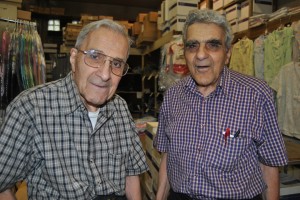This article ran in the August 2011 edition of the Red Hook Star-Revue. We reprint it today as a tribute to younger brother Mat, whose funeral is this Saturday in Howard Beach.
Floor to ceiling, he’s surrounded by racks, shelves and boxes full of clothing. But Joe Chirico goes straight to the spot behind a cluttered display stand where he’s tucked a cardboard box containing bowties and skinny ties, accessories that were popular decades ago.

“That’s an old style,” he says, pulling out a paisley bowtie.
These days, if someone comes in to Marietta’s clothing store on Court Street asking for a bowtie, Joe, 90, and his brother Mat, 84, give them away for free. The brothers’ store is a longtime fixture on a street now peppered with coffee shops, vintage stores, cafes and boutiques. It has survived as other nearby businesses have failed, and as the neighborhood went from mostly working-class Italian and Irish-American families to today’s influx of young families and professionals.
The Chirico brothers, both World War II veterans, took over the business about 60 years ago after it was founded by their mother in 1940. “We came out of the service and didn’t have no jobs,” Mat said. The store’s longevity seems slightly unlikely in an increasingly trendy neighborhood. The narrow space is packed with pastel housedresses , underwear, nightgowns, cotton pajama sets and men’s work clothes.
A sign at the register reads “Please do not be in a hurry. Thank you!” The brothers pay little attention to fashion trends, and their merchandise has remained largely the same for the past six decades. “What the people want – that’s style,” Joe says. “Nobody comes in for style, if they wanted style they wouldn’t come in here.” But there are items here that hard to find – practical things like slips and generously-sized panties. And the prices are good. Trouser socks are $1, collared shirts are $13, pants are $20 and entire outfits for babies are $10. Their prices stay low because they don’t mark them up, Mat says. “We don’t have to, we own the building.”
From Red Hook to Carroll Gardens
The neighborhood has gone from being called Red Hook, to South Brooklyn, and today, Carroll Gardens. The brothers remember when Court Street was “even busier than this,” and when Carroll Park was overrun with children. “People had more kids then,” Mat said. And if their merchandise hasn’t Marietta’s Dry Goods Store has been at 392 Court Street looking just about the same since before World War 2. Photo by Elizabeth Graham Joe, left, and Mat Chirico are in the middle of a nice long run operating their dry goods store the old fashioned way. They fought in WW 2 and then returned to work in the store their mother founded. They are still running it, pretty much as always.
Before Victoria’s Secret, this was the way that America bought it’s underwear, and if you don’t need the frills this is still the best way. Photo by Elizabeth Graham Go To Marietta’s to See How It Used to be Around Here by Elizabeth Graham These days, if someone comes in to Marietta’s clothing store on Court Street asking for a bowtie, Joe, 90, and his brother Mat, 84, give them away for free. kept up with changing fashion, it has evolved to fit demand. Gone are baptismal clothes, hand-embroidered dresses, cloth diapers and rubber pants for children, along with rubber girdles for women. (And men, too, Joe says.)
The conversation stops when customers come in. Mat breaks off to help a woman look for her size in a box of bras, and another customer in search of a slip addresses him as “Matty.” The brothers say they don’t know exactly what keeps customers, who range from kids to a 100-year old woman, coming into the store. “I can’t answer that, they’ve got to answer that,” Mat says. “You know what I think it is – hard work and ambition.” But business isn’t the same, they say. “You don’t get the families anymore,” Mat says. “Years ago, people used to come in with four, six, eight kids. Those were the better times, years ago.”









One Comment
Wow.My Mom must remember this store she was born and raised on president street in 1944.Perhaps you knew her.Her name was Maria Carlino.But they called her Connie or Conneta.Her parents were Angelo &Vinzenza Carlino.If you may rememeber the family.Plse reach out to me 347 444 9867.Lookin for history.